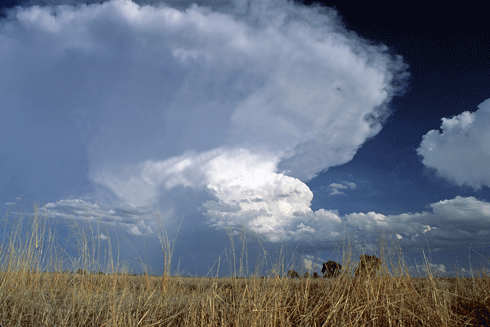
|
Published: 8 October 2012
Less rain as sub-tropical dry-zone moves poleward
A decline in rainfall over south-east Australia in April-May of this year is associated with a southward expansion of the subtropical dry-zone, according to research just published in Scientific Reports, a research journal from the publishers of Nature.

|
|
Storm clouds near Griffith, NSW: Scientists have evidence that south-east Australia has less autumn rainfall due to an expansion of the sub-tropical dry-zone. Credit:
Gregory Heath/CSIRO
|
CSIRO scientists Wenju Cai, Tim Cowan and Marcus Thatcher explored why autumn rainfall has been in decline across south-eastern Australia since the 1970s, a period that included the devastating ‘millennium drought’ from 1997-2009.
Previous research into what has been driving the decline in autumn rainfall across regions like southern Australia has pointed to a southward shift in the storm tracks and weather systems during the late 20th century. However, the extent to which these regional rainfall reductions are attributable to the poleward expansion of the subtropical dry-zone has not been clarified until now.
Mr Cowan said rainfall patterns in the subtropics are known to be influenced by the Hadley cell, the large-scale atmospheric circulation that transports heat from the tropics to the sub-tropics.
‘There has been a southward expansion of the edge of the Hadley cell – also called the subtropical dry-zone – over the past 30 years, with the strongest expansion occurring in mid-late autumn, or April to May, ranging from 200 to 400 kilometres,’ Mr Cowan said.
The CSIRO researchers found that the autumn southward expansion of the subtropical dry-zone is greatest over south-eastern Australia, and to a lesser extent, over the Southern Ocean to the south of Africa.
‘The Hadley cell is comprised of a number of individual branches, so the impact of a southward shift of the subtropical dry-zone on rainfall is not the same across the different semi-arid regions of the Southern Hemisphere,’ says CSIRO’s Dr Wenju Cai.
The researchers tested the hypothesis that the dry-zone expansion would give rise to a southward shift in the average rainfall during April and May, and questioned how rainfall across semi-arid regions, including southern-coastal Chile and southern Africa, would be affected.
‘During April and May, when the dry-zone expansion is strong, rainfall over south-eastern Africa, south-eastern Australia and southern-coastal Chile is higher than over regions immediately to their north,’ Dr Cai said.
Using high-quality observations and an atmospheric model the CSIRO team found that for south-eastern Australia, up to 85 per cent of recent rainfall reduction can be accounted for by replacing south-eastern Australia rainfall with rainfall 400 km to the north. Such a southward shift of rainfall can explain only a small portion of the southern Africa rainfall trend, but none of the autumn drying observed over southern Chile.
‘For south-east Australia, autumn is an important wetting season,’ Dr Cai explained. ‘Good autumn rainfall wets the soil and effectively allows for vital runoff from follow-on winter and spring rain to flow into catchments.’
According to the study an important issue remains as to why the poleward expansion is largest in autumn, and there is still uncertainty about the role of external forcings – such as greenhouse gases – as climate models underestimate the southward expansion of the Hadley cell edge.
The research was conducted through CSIRO’s Water for a Healthy Country Flagship, and funded by the Goyder Institute for Water Research and the Australian Climate Change Science Programme.
Source: CSIRO



